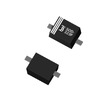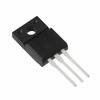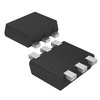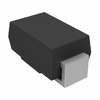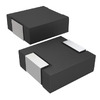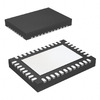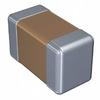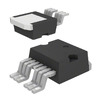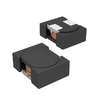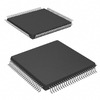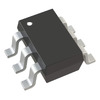From Theory to Practice: Implementing the LM2596 Voltage Regulator in Your Projects
A voltage regulator is a power supply circuit or equipment that can automatically adjust the output voltage. It can stabilize the power supply voltage that fluctuates greatly or does not meet the requirements of electrical equipment within the set value range, enabling various circuits or electrical equipment to work normally at the rated working voltage. Below, we will delve into the features, pin configuration, structure, PCB layout principle, and applications of LM2596 voltage regulator.
Catalog

What is a Voltage Regulator?
A voltage stabilizer is a device that keeps the output voltage stable and consists of a control circuit, a voltage regulating circuit, a servo motor, etc. When the input voltage or load changes, the control circuit will react to the sampling, comparison, and amplified results, and then drive the servo motor. This process causes the carbon brush position of the voltage regulator to change, automatically adjusting the coil turns ratio to maintain the stability of the output voltage.
Voltage regulators are mainly divided into linear regulators and switching regulators. Both regulate system voltage, but linear regulators are less efficient, while switching regulators are more efficient. High-efficiency switching regulators can transfer most of the input power to the output without loss.
Overview of LM2596 Voltage Regulator
LM2596 is a 3A current output step-down switch type integrated voltage regulator chip manufactured by Texas Instruments. It is equipped with a fixed frequency oscillator (150KHZ) and a reference voltage regulator (1.23v), and has complete protection circuits, including current limiting and thermal shutdown circuits. The use of this chip can greatly reduce the demand for peripheral devices, thereby constructing efficient voltage stabilizing circuits.
The chip integrates frequency compensation and fixed frequency generator internally, with a switching frequency of 150KHz. Compared with low-frequency switch regulators, it can use smaller specifications of filtering components. Due to the fact that the device only requires a minimum of 4 external components and can use universal standard inductors, the use of LM2596 is optimized, significantly simplifying the design of the switching power supply circuit.
Replacements and Equivalents
• ACT4523
• BD9876
• LM2576
Features of LM2596 Voltage Regulator
• Low power standby mode, typical IQ value is 80uA
• Its peripheral circuit is simple, requiring only at least 4 external components.
• It uses an internal oscillation frequency of 150KHz and is a second-generation switching voltage regulator with low power consumption and high efficiency.
• It can achieve external power-off with only 80uA standby current.
• It has self-protection circuits (a two-stage frequency reduction current-limiting protection and an over-temperature complete protection circuit that cuts off power under abnormal conditions).
• Under specific input voltage and output load conditions, the output voltage error can be guaranteed to be within the range of ±4%, and the oscillation frequency error can be guaranteed to be within the range of ±15%.
Pin Configuration of LM2596 Voltage Regulator
LM2596 has a total of five pins. Its pin names and functions are as follows.
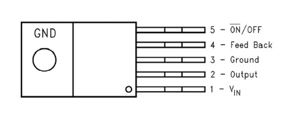
Pin 1 (Vin): It is the positive input power supply of the IC switching regulator. A suitable input bypass capacitor must be present on the pin to minimize voltage transients and provide the required switching current to the regulator.
Pin 2 (OUT): Internal switch. The voltage on this pin switches between approximately (+VIN-VSAT) and approximately -0.5V with a duty cycle of VOUTVIN. To minimize coupling to sensitive circuitry, we must keep the pcb copper area connected to this pin to a minimum.
Pin 3 (GND): Circuit ground
Pin 4 (FB): Sensing the adjusted output voltage to complete the feedback loop.
Pin 5 (ON’/OFF): It allows a logic signal to be used to turn off the switching regulator circuit, thereby reducing the total input supply current to approximately 8OuA. Pulling this pin below a threshold voltage of approximately 1.3 V turns the regulator on, while pulling this pin above 1.3V (up to 25V) turns the regulator off. If this shutdown feature is not required, the on/off pin can be wired to the ground pin or left on. In either case, the regulator will be in the ON state.
Structure of LM2596 Voltage Regulator
LM2596 usually contains the following parts.
Reference voltage source
Inside the LM2596, typically at 1.23V, we'll find a reference voltage source. This reference voltage serves as a basis for comparing the input voltage and output voltage, ensuring the stability of the output voltage.
Feedback loop and error amplifier
It includes a feedback loop that measures the output voltage (Vout) and compares it to a reference voltage. In this way, any deviation in the output voltage generates an error signal that is amplified and used to adjust the duty cycle of the switching FET to maintain stability.
Protection circuit
It contains built-in features of thermal shutdown and current limiting to protect the IC and connected components from damage.
Control logic
Internal control logic manages timing and switching operations. It usually runs at a fixed frequency and is responsible for turning the internal FETs on and off.
Internal switching transistor (FET)
It usually contains an internal power N-channel field-effect transistor (FET) used as the switching element. This FET allows the LM2596 to switch current paths, thereby reducing the voltage.
LM2596 PCB Layout Guidelines

As in any switching regulator, the layout of the printed circuit board is very important. Rapidly switching currentsassociated with wiring inductance, stray capacitance and parasitic inductance of the printed circuit board traces can generate voltage transients which can generate electromagnetic interferences (EMI) and affect the desired operation. As indicated in the picture, to minimize inductance and ground loops, the length of the leads indicated by heavy lines should be kept as short as possible. For best results, single-point grounding or ground plane construction should be used.
On the other hand, the PCB area connected to the Pin 2 (emitter of the internal switch) of the LM2596 should be kept to a minimum in order to minimize coupling to sensitive circuitry.
Another sensitive part of the circuit is the feedback. It is important to keep the sensitive feedback wiring short. To assure this, physically locate the programming resistors near to the regulator, when using the adjustable version of the LM2596 regulator.
What is the PWM Control Principle of LM2596 Voltage Regulator?
The LM2596 employs PWM control to maintain a consistent output voltage by modulating the switching tube's on and off periods. When the input voltage exceeds the output voltage, the switch tube activates, causing the inductor to store energy, the capacitor to discharge, and the output voltage to remain stable. Conversely, when the input voltage falls below the output voltage, the switch deactivates, leading to energy release from the inductor, capacitor charging, and stable output voltage. This PWM control mechanism enables precise regulation of the output voltage.
Applications of LM2596 Voltage Regulator
• Wireless Communication: It can be used in various wireless communication devices that need to provide stable power, including Bluetooth modules, WiFi routers, and mobile communication devices. It can effectively convert unstable power supply voltage into stable output voltage, thus ensuring the normal operation of wireless communication equipment.
• LED Lighting: LM2596 can be used to dim and control LED lighting systems to ensure constant brightness and stable power supply.
• Electronic Prototyping: It is also commonly used in electronic prototyping as it is easy to use and less expensive and can provide the required power.
• Power Supply: LM2596 can be used to design various types of power supplies, including switching power supplies and linear power supplies. It can convert high-voltage input (such as 12V or 24V) into the low-voltage output (such as 5V or 3.3V) you need, providing stable and reliable power for sensors, LED lighting, microcontrollers, electronic devices, etc.
Frequently Asked Questions [FAQ]
1. Can LM2596 Step Up?
The board's input voltage can be between 4V and 35V; it's output voltage can be adjusted between 1.25V and 25V. One of the regulators on the board is a step-down converter and the other is step-up converter.
2. What is the Function of LM2596?
The LM2596 series of regulators are monolithic integrated circuits that provide all the active functions for a step-down (buck) switching regulator, capable of driving a 3-A load with excellent line and load regulation.
3. What is the Design of LM2596 Power Supply?
The LM2596 is essentially a voltage regulator designed as a buck converter. It can handle input voltages up to 40V, efficiently stepping them down to produce a lower, stable output voltage (Vout) that can be as low as 3V or as high as 35V.
4. What is the Input Range of LM2596?
The LM2596 is a commonly used popular step-down switching regulator IC. The adjustable version can take in input voltage from 4.5V to 40V and convert it to variable voltage sourcing upto of 3A of continues current.
5. What is the Use of LM2596 Step Down Converter?
The LM2596 DC-DC Buck Converter is a versatile and useful tool for converting a higher input voltage to a lower output voltage. It can be used to power multiple devices with different voltage requirements from a single source, and has built-in over-current protection for added safety.
About us
ALLELCO LIMITED
Read more
Quick inquiry
Please send an inquiry, we will respond immediately.
→ Previous

Transistors play an important role in electronic devices, and they are widely used in the design of analog and digital circuits. At present, bipolar transistors and junction field-effect transistors have been widely used, but the most widely used one is the metal oxide semiconductor field-effect tra...

2N2222 and BC547 are both NPN-type general-purpose low-power transistors, which are widely used in circuits such as audio amplifiers and frequency oscillators. In this article, we will compare both in terms of symbol, technical parameters, features, applications, and working principles. Catalog1. Wh...
→ Next

2N7000 vs BS170: Comparing Two Popular N-Channel MOSFETs
on April 29th

From Audio Amplifiers to Frequency Oscillators: Analyzing 2N2222 and BC547 Transistors
on April 29th
Popular Posts
-

What is GND in the circuit?
on January 1th 3272
-

RJ-45 Connector Guide: RJ-45 Connector Color Codes, Wiring Schemes, R-J45 Applications, RJ-45 Datasheets
on January 1th 2815
-

Understanding Power Supply Voltages in Electronics VCC, VDD, VEE, VSS, and GND
on November 20th 2640
-

Fiber Connector Types: SC Vs LC And LC Vs MTP
on January 1th 2265
-

Comparison Between DB9 and RS232
on January 1th 1882
-

What Is An LR44 Battery?
Electricity, that ubiquitous force, quietly permeates every aspect of our daily lives, from trivial gadgets to life-threatening medical equipment, it plays a silent role. However, truly grasping this energy, especially how to store and efficiently output it, is no easy task. It is against this background that this article will focus on a type of coin cell battery that may seem insignificant on the...on January 1th 1846
-

Understanding the Fundamentals:Inductance Resistance, andCapacitance
In the intricate dance of electrical engineering, a trio of fundamental elements takes center stage: inductance, resistance, and capacitance. Each bears unique traits that dictate the dynamic rhythms of electronic circuits. Here, we embark on a journey to decipher the complexities of these components, to uncover their distinct roles and practical uses within the vast electrical orchestra. Inductan...on January 1th 1807
-

What Is RF and Why Do We Use It?
Radio Frequency (RF) technology is a key part of modern wireless communication, enabling data transmission over long distances without physical connections. This article delves into the basics of RF, explaining how electromagnetic radiation (EMR) makes RF communication possible. We will explore the principles of EMR, the creation and control of RF signals, and their wide-ranging uses. The article ...on January 1th 1801
-

CR2430 Battery Comprehensive Guide: Specifications, Applications and Comparison to CR2032 Batteries
What is CR2430 battery ?Benefits of CR2430 BatteriesNormCR2430 Battery ApplicationsCR2430 EquivalentCR2430 VS CR2032Battery CR2430 SizeWhat to look for when buying the CR2430 and equivalentsData Sheet PDFFrequently Asked Questions Batteries are the heart of small electronic devices. Among the many types available, coin cells play a crucial role, commonly found in calculators, remote controls, and ...on January 1th 1799
-

Comprehensive guide to hFE in transistors
Transistors are crucial components in modern electronic devices, enabling signal amplification and control. This article delves into the knowledge surrounding hFE, including how to select a transistor's hFE value, how to find hFE, and the gain of different types of transistors. Through our exploration of hFE, we gain a deeper understanding of how transistors work and their role in electronic circu...on November 20th 1782









